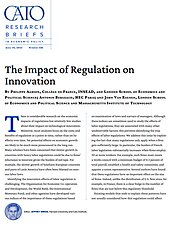There is considerable research on the economic impacts of regulations but relatively few studies about their impact on technological innovation. Moreover, most analyses focus on the costs and benefits of regulation at a point in time, rather than on its effects over time. Yet potential effects on economic growth are likely to be much more pronounced in the long run. Many scholars have been concerned that slower growth in countries with heavy labor regulations could be due to firms’ reluctance to innovate given the burden of red tape. For example, the slower growth of Southern European countries and parts of Latin America have often been blamed on onerous labor laws.
Identifying the innovation effects of labor regulation is challenging. The Organisation for Economic Co-operation and Development, the World Bank, the International Monetary Fund, and other agencies have developed various indices of the importance of these regulations based on examination of laws and surveys of managers. Although these indices are sometimes used to study the effects of labor regulations, they are associated with many other unobservable factors; this prevents identifying the true effects of labor regulations. We address this issue by exploiting the fact that many regulations only apply when a firm gets sufficiently large. In particular, the burden of French labor legislation substantially increases when firms employ 50 or more workers. For example, such firms must create a works council with a minimum budget of 0.3 percent of total payroll, establish a health and safety committee, and appoint a union representative. Several authors have found that these regulations have an important effect on the size of firms. Indeed, unlike the distribution of U.S. firm sizes, for example, in France, there is a clear bulge in the number of firms that are just below this regulatory threshold.
Existing models that seek to explain these patterns have not usually considered how this regulation could affect innovation. But when firms are choosing whether to invest in innovation, regulations are likely to matter. Intuitively, French firms may invest less in research and development as there is a very high cost of growing if the firm crosses the 50-employee threshold. We developed a model that generates the intuitive prediction that the regulatory threshold discourages innovation most strongly for firms just below the threshold. However, the threshold also discourages innovation for all firms larger than the threshold because the growth benefits of innovation are lower due to the implicit regulatory tax.
We use the sudden increase in cost at the regulatory threshold to test the theory in two ways when taking it to our data on French firms. First, we investigate how innovation (measured by patents held) changes with firm size. As expected, there is a sharp fall in the fraction of innovative firms just below the 50-employee threshold, an “innovation valley” that suggests a chilling effect of the regulation on the desire to grow. Moreover, the share of firms with a given number of employees grows more slowly above the threshold, consistent with a greater tax on growth.
Although the previous evidence is suggestive of labor regulation stifling innovation, there could be other reasons why we see an innovation valley near the threshold. So, we turn to a second and stronger test by exploiting data on firms over time. Previous research predicts that an increase in demand should have a positive effect on innovation. Thus, we analyze how firms of various sizes respond differently to sudden demand increases, measured by changes in the growth of markets for exported products. We first show that these positive demand increases significantly raise innovative activity. We then examine differences in firm responsiveness to these demand increases depending on firm size prior to the demand increase. We find a sharp reduction in firms’ innovation response to the demand increase for firms with size just below the 50-employee threshold. Consistent with intuition and our model, firms appear reluctant to take advantage of market growth through innovating if they will then be subject to a wave of labor regulation.
Our estimates suggest that the French labor regulation is equivalent to a tax on profit of about 2.6 percent that reduces total innovation by about 5.8 percent—equivalent to cutting the annual growth rate from 1.7 to 1.6 percent—and reduces welfare by at least 2.3 percent in terms of consumption. This results partly from discouraging the creation of new firms and incentivizing existing firms to employ fewer people. However, most of this impact is from lower innovation per firm once they reach a certain size. This implies that previous research that focuses on output loss at a point in time—rather than over time—has significantly underestimated the cost of the regulation.
Also, we find that the effect of French labor regulations differs between radical innovation (creating new technology) and incremental innovation (improving existing technology). We classify patents as radical or incremental by citations in future patent applications and the novelty of the patent text and find that the negative effects of regulations are confined to incremental patents. Radical innovation is likely unaffected because if a firm decides to innovate despite the chance of incurring heavy regulatory costs, it will try to “swing for the fence” to avoid landing only slightly above the 50-employee threshold. We also find that regulation biases innovation toward technology that replaces labor with automation.
NOTE
This research brief is based on Philippe Aghion, Antonin Bergeaud, and John Van Reenen, “The Impact of Regulation on Innovation,” Programme on Innovation and Diffusion Working Paper no. 1, January 2021.

This work is licensed under a Creative Commons Attribution-NonCommercial-ShareAlike 4.0 International License.
